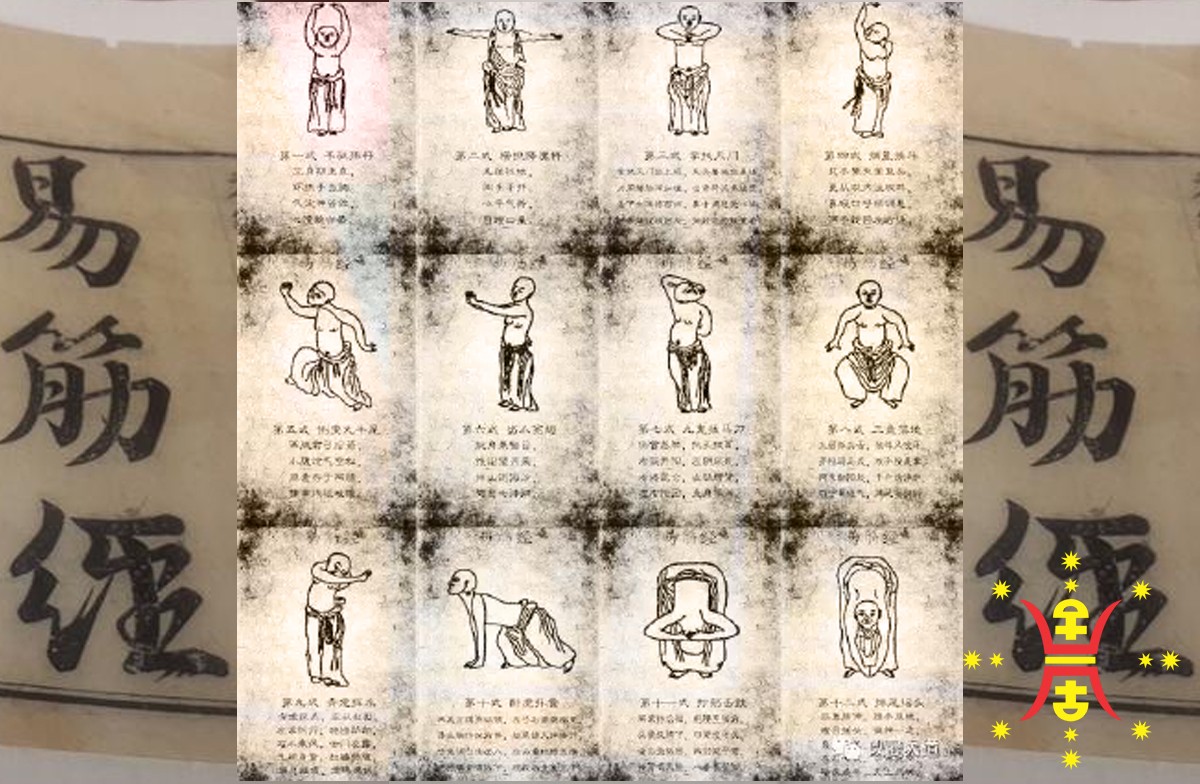Yijinjing - Rejuvenating Exercise: Ancient Qigong for Physical Harmony
The Yijinjing, also known as the Rejuvenating Exercise, is a Qigong practice primarily focused on strengthening the muscles for overall health and well-being. Emphasizing the coordination of body posture, breathing, and mental focus, the Yijinjing is attributed to the revered Indian monk Bodhidharma during the Northern and Southern Dynasties (or alternatively, to General Li Jing of the early Tang Dynasty according to some accounts). The practice has various lineages, with three main versions: the "Yamen Cangban" Yijinjing (including the "Xisuijing" volume, hence also known as "Xisui Yijinjing") featuring twelve movements; three sets of twenty-two movements in "Zhongwai Weisheng Yaozhi"; and twenty-four movements in "Shaolin Internal Skill Secret Transmission." These twenty-four movements are further categorized into twelve stances, including Weituo Xianchu, Zhaixing Huandou, Daopu Jiuniuwei, Chuzhao Liangchi, Jiugui Bama Dao, Sanpan Luodi, Qinglong Tanzhao, Wohu Pushi, Dangong, Diaowei, among others.
Weituo Xianchu, the First Stance:
In this stance, the left foot takes a step to the left, hands naturally hanging down. Maintain an upright posture, gaze forward, with a clear mind and composed spirit. Slowly transition both hands from yang (palms facing down) to lifting upward, level with the shoulders. Then, bring both palms close to the chest, clasping hands in front of the chest with fingertips pointing upward. Perform abdominal breathing, directing the intention to the Dantian.
Weituo Xianchu, the Second Stance:
Continuing from the previous stance, both palms gradually transition to yang palms, separating to the sides. Both arms extend horizontally, forming a straight line. The heels slightly lift, and natural breathing is maintained while gazing forward.
Weituo Xianchu, the Third Stance:
Following the previous stance, both hands slowly lift from the sides, changing from yang to yin palms. The fingertips of both hands face each other, forming a supporting-the-heavens posture above the forehead. Simultaneously, the heels lift, clench the teeth, and press the tongue against the palate. Subsequently, clench the fists and slowly return along the original path.
Zhaixing Huandou Stance:
Continuing from the previous stance, the right hand slightly raises towards the upper right, maintaining a fist-width distance from the forehead. Simultaneously, the left hand lowers and reverses to place the back of the hand against the right side of the waist. Both eyes gaze upwards at the palm of the right hand. Then, the left hand rises to cover the forehead, while the right hand lowers, placing the back of the hand against the left side of the waist.
DaoZhuai Jiuniuwei Stance:
Continuing from the previous stance, the right hand moves away from the waist, slightly bending downward and transitioning into a yang palm, sweeping towards the front right. The right leg steps forward to form a front bow stance, and the left hand simultaneously lowers, sweeping towards the back left. Then, switch to left and right bow stances, with the left hand reversing and sweeping towards the front left, and the right hand retracting towards the back right. The movements are repeated on both sides.
Chuzhao Liangchi Stance:
Continuing from the previous stance, utilizing the momentum of the previous movement's pullback, the front leg is retracted, and both feet come together. Both hands retract, palms facing forward, fingertips pointing upward, positioned at the chest and ribs. Then, both palms are slowly pushed forward, concentrating mental focus and observing both palms. Subsequently, the palms are slowly retracted towards the chest and ribs, placed on both sides of the chest. This is repeated seven times. At the extreme, it feels as heavy as removing a mountain.
Jiugui Bama Dao Stance:
Continuing from the previous stance, the right hand rises upward, making a circular motion towards the back of the head, placing the palm against the back of the head, and the right armpit opens. The left hand sweeps towards the left side, placing the back of the hand between the two shoulder blades, closing the left armpit. Following the previous movement, the right hand is lowered, and the left hand is raised in reverse, placing the back of the hand between the two shoulder blades. Simultaneously, the right hand is raised to the back of the head. This sequence is repeated several times.
Sanpan Luodi Stance:
Continuing from the previous stance, both hands extend horizontally to the left and right, forming a straight line, with palms facing down. At the same time, the left foot takes a large step to the left. Slowly squat into a horse-riding stance; during the squat, both hands also press down gradually until they are level with the knees. Following this, the palms are turned over, palms facing upward as if holding an object, and, with the slow extension of both legs, rise together until level with the chest. This is repeated several times.
Qinglong Tanzhao Stance:
Continuing from the previous stance, the left foot is retracted to be as wide as the shoulders, and the left hand flips the palm downwards. Using the waist's force, the tip of the left elbow leads and retracts towards the left rear, while the right palm also flips downwards, extending towards the right side. Following the previous movement, the right hand is lowered, and the left hand is raised, with the back of the hand between the two shoulder blades. This is repeated on both sides. Gaze naturally, breathe naturally, and keep the mind calm.
Wohu Pushi Stance:
Continuing from the previous stance, lift the right leg forward to take a step to the right, forming a bow stance, and simultaneously, both hands move forward, with all five fingers touching the ground, palms facing down. Slightly lift the head while looking upwards. Retract the front foot, first perform a downward bend, slowly retract the hips, and gaze straight ahead. Then, lift the head, as if pouncing for food. Repeat this movement several times. Finally, return to the standing position with both feet shoulder-width apart.
Dagong Stance:
Continuing from the previous stance, both feet are shoulder-width apart, standing upright. Both hands embrace the head, palms against the ears, and the tips of the two middle fingers lightly touch. Both elbows are bent. Slowly bend the body, bowing at the waist, lowering the head between the knees to the space between the two knees, with the legs straight and the waist and hips relaxed. Press the tongue against the palate, and bite down on the teeth. Then, slowly straighten up. Repeat this movement several times.
Diaowei Stance:
Continuing from the previous stance, both hands are pushed forward from behind the head, straightening both arms to be level with the shoulders. Cross the fingers of both hands, with palms facing the ground, slowly bring them towards the chest, then slowly push down. When the waist is bent to the limit, push both hands down to the ground. Both legs are kept straight. Following this, slowly raise the waist, simultaneously raise both hands, and separate them while swinging to the left and right seven times. At the same time, both feet stomp on the ground seven times.
When you subscribe to the blog, we will send you an e-mail when there are new updates on the site so you wouldn't miss them.














Comments